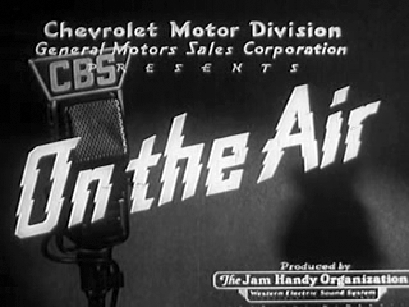
On the Air
Jam Handy, 1937 - 9:53
Music: Rubinoff & His Violin
Sponsored by General Motors
|
Mister Valve had a great time watching this rather backhanded plug for a Chevrolet-sponsored radio show, but probably for all the wrong reasons. It starts out as one of those behind-the-scenes flicks, where we see the always-interesting process of a live program being made, complete with an orchestra all dressed up as if they were playing Carnegie Hall instead of a union-scale studio gig. Rubinoff was by then a widely acclaimed virtuoso on the violin, with world concert tours and appearances on several other shows, notably the Chase & Sanborn Hour. He thus gives this modest little corporate flick some real star power. Around four minutes in, however, the film shifts inexplicably into an elementary school level explanation of AM radio. It's all rather silly, complete with the inevitable rock being dropped into a pond to illustrate wave behavior, and fake scope traces where the wavelength seems to increase with every amplification of signal. However, we do get to see the audio start its electrical journey through a really cool cutaway of how a ribbon mike works. This shot is up to the usual high standards for Handy Organization film graphics, and worth the whole flick. Having thus had his priceless violin converted to prosaic alternating current, Mr. Rubinoff travels through all kinds of great 1930s equipment, down the dedicated phone line to a Western Electric transmitter, Blaw-Knox tower, the Aether, and finally your own "aerial" and superheterodyne. If you're into old broadcasting gear, back when transmitter control consoles were wooden and engineers were iron, this is your flick. The station shown is one of those huge old flamethrowers, probably WJR in Detroit. Mr. Rubinoff goes through some truly impressive valves. The miracle of RF starts in the feeble "electric pump" called the "oscillator," while meanwhile the music goes round and round, and finally meets the huge water-cooled PA and Mister Modulator. Ultimately, his famous Stradivarius "thunders out with a power strong enough to carry it over a wide radius." Whoo-HOOO! DO check out the ending, with the whole family at a picnic, grokking Mr. Rubinoff's Strad from the cranked-up car radio in their shiny new Chevy. So that's what car sets looked like in 1937 ("This tube is called a 'detector'.") Nice antenna in the running board. |
|
|





|
|

|
Handy's cutaway of the classic RCA Type 44A ribbon mike as used at CBS. It's still one of the best sounding broadcast microphones ever made. Announcers with the right voice who learn to work its proximity effect get that solid old-radio sound which still says class. |
|
From the 44A and mixer to the really ominous old style audio rack, with 241 plugs, stepped attenuators, and phone transfer keys. |
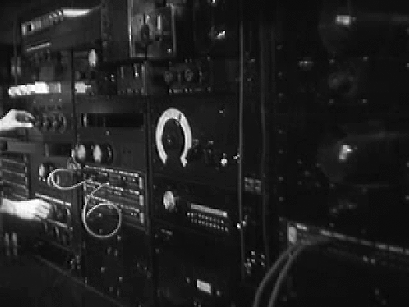
|
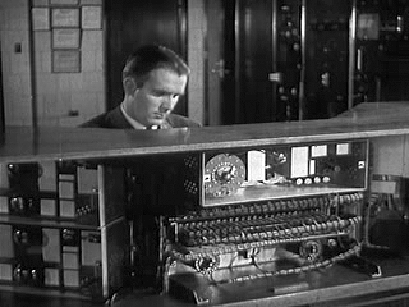
|
Through the expensive leased/conditioned landlines to the control console at the transmitter, the back of which has just magically dissolved away. Note (A) the cool lighting on his face, and (B) the transmitter and old-style FCC licenses in the back. |
|
The miracle of radio carrier wave starts here, in the oscillator - or something. Again, their lighting guy really earned his dinner on this shot. |
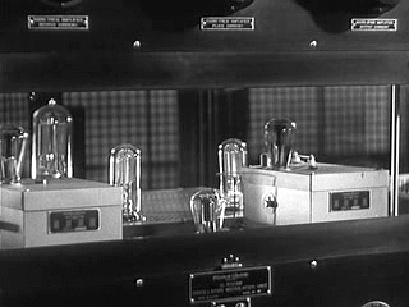
|
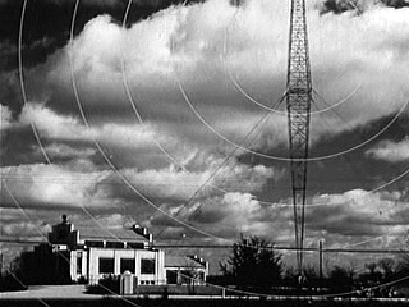
|
Through more glass things, and out to the mighty radio tower, a classic Blaw-Knox built like a battleship. From here, white circles spread out, bringing Mr. Rubinoff's magic violin to an anxiously awaiting world. The distinctive, Zigzag Moderne, transmitter building looks like WJR, AM 760, Detroit. It's still there, but newer photos show a more prosaic two-tower setup. |
|
The End. Handy loved to end his stuff for Chevy with this spinning auto wheel, then fade out close on the hubcap of a car. Industrial film, indeed. |
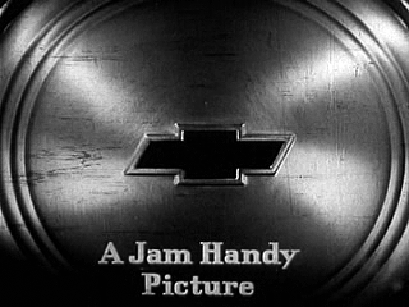
|
Back to movies
Back to tubepage
-- .- -.-- -... .
-.-- --- ..- .-.
..-. .. -. .- .-..
-.-. --- ... - ...
.---- .-.-.- ..--- ----.